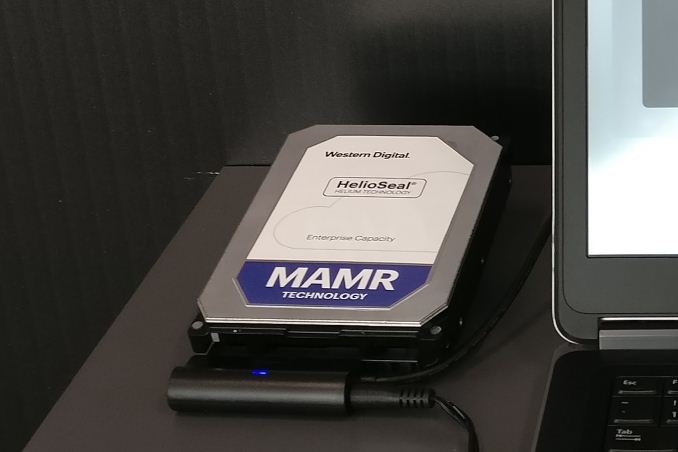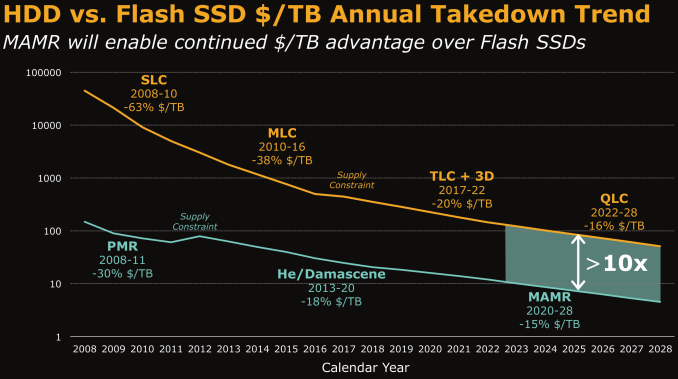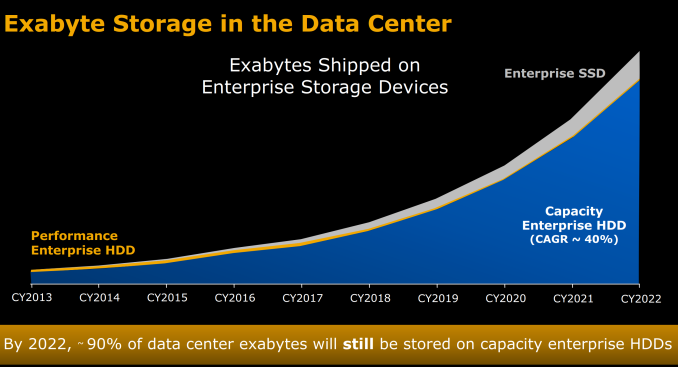Western Digital Stuns Storage Industry with MAMR Breakthrough for Next-Gen HDDs
by Ganesh T S on October 12, 2017 8:00 AM EST
Yesterday, Western Digital announced a breakthrough in microwave-assisted magnetic recording (MAMR) that completely took the storage industry by surprise. The takeaway was that Western Digital would be using MAMR instead of HAMR for driving up hard drive capacities over the next decade. Before going into the specifics, it is beneficial to have some background on the motivation behind MAMR.
Hard drives may be on the way out for client computing systems, but, they will continue to be the storage media of choice for datacenters. The Storage Networking Industry Association has the best resources for identifying trends in the hard drive industry. As recently as last year, heat-assisted magnetic recording (HAMR) was expected to be the technology update responsible for increasing hard drive capacities.

Slide Courtesy: Dr.Ed Grochowski's SNIA 2016 Storage Developer Conference Presentation
'The Magnetic Hard Disk Drive: Today’s Technical Status and Its Future' (Video, PDF)
Mechanical Hard Drives are Here to Stay
One of the common misconceptions amongst readers focused on consumer technology relates to flash / SSDs rendering HDDs obsolete. While using SSDs over HDDs is definitely true in the client computing ecosystem, it is different for bulk storage. Bulk storage in the data center, as well as the consumer market, will continue to rely on mechanical hard drives for the foreseeable future.
The main reason lies in the 'Cost per GB' metric.
Home consumers are currently looking at drives to hold 10 TB+ of data, while datacenters are looking to optimize their 'Total Cost of Ownership' (TCO) by cramming as many petabytes as possible in a single rack. This is particularly prevalant for cold storage and archival purposes, but can also expand to content delivery networks. Western Digital had a couple of slides in their launch presentation yesterday that point towards hard drives continuing to enjoy this advantage, thanks to MAMR being cost-effective.
Despite new HDD technology, advancements in solid state memory technology are running at a faster pace. As a result SSD technology and NAND Flash have ensured that performance enterprise HDDs will make up only a very minor part of the total storage capacity each year in the enterprise segment.
The projections presented by any vendor's internal research team always need to be taken with a grain of salt, but given that SanDisk is now a part of Western Digital the above market share numbers for different storage types seem entirely plausible.
In the next section, we take a look at advancements in hard drive technology over the last couple of decades. This will provide further technical context to the MAMR announcement from Western Digital.












127 Comments
View All Comments
Jaybus - Monday, October 16, 2017 - link
1 gigabit Ethernet has an upper limit of 125 MB/s. It would take a minimum of 320,000 seconds or around 3.7 days of continuous 125 MB/s transfer rate to backup a 40 TB drive. Cloud backup of large volumes of data isn't going to be practical until at least 20 gigabit connections are commonplace.tuxRoller - Thursday, October 12, 2017 - link
Backing up to the cloud is really slow.Retrieving from the cloud is really slow.
When gigabit becomes ubiquitous then it will make more sense.
Even then, your should keep at least one copy of the data for data about offline and local.
Btw, I agree that raid is dead, but for different reasons. Namely, we've the much more flexible erasure coding (much more sophisticated than the simple xor encoding used by some of the raid levels) schemes that let you apply arbitrary amounts of redundancy and decide on placement of data. That's what the data centers have been moving towards.
alpha754293 - Thursday, October 12, 2017 - link
Even with Gb WAN, it'd still be slow.I have GbE LAN and I'm starting to run into bottlenecks with that being slow that once I have the funds to do so, I'm likely going to move over to 4x FDR IB.
tuxRoller - Thursday, October 12, 2017 - link
Slower than an all ssd, 10g lan, but how many people have that? 1g is roughly HDD speed.BurntMyBacon - Friday, October 13, 2017 - link
@tuxRoller1Gbps = 128MBps. cekim seems to think that 250MBps is a better estimate and alpha75493 suggests that these drives will increase in speed well beyond that. Granted this will not hold up for small file writes, but for large sequential data sets, the days of 1G ethernet being roughly equal to HDD speed are soon coming to an end.
tuxRoller - Friday, October 13, 2017 - link
Even now HDD have sequential (non-cached) speeds in excess of 300MB (for enterprise 15k drives), but 250MB+ is currently available with the 8TB+ 7200 drives.Those are best case, but they might also be readily achievable depending on how your backup software works (eg., a block-based object store vs NTFS/zfs/xfs/etc).
alpha754293 - Thursday, October 12, 2017 - link
@cekimYour math is a little bit off. If the areal density increases from 1.1 Tb/in^2 to 4 Tb/in^2, then so too will the data transfer speeds.
It has to.
Check that and update your calcs.
@imaheadcase
RAID is most definitely not dead.
RAID HBAs addressing SANs is still farrr more efficient to map (even with GPT) a logical array rather than lots of physical tables.
You do realise that there are rackmount enclosures that hold like 72 drives, right?
If that were hosted as a SAN (or iSCSI), there isn't anything that you can put as AICs that will allow a host to control 72 JBOD drives simultaneously.
It'd be insanity, not to mention the cabling nightmare.
bcronce - Thursday, October 12, 2017 - link
Here's an interest topic on raid rebuilds for ZFS. While it can't fix the issue of writing 250MiB/s to a many TiB storage device, it is fun.Parity Declustered RAID for ZFS (DRAID)
A quick overview is that ZFS can quickly rebuild a storage device if the storage device was mostly empty. This is because ZFS only needs to rebuild the data, not the entire drive. On the other hand, as the device gets fuller, the rate of a rebuild gets slower because walking the tree causes random IO. DRAID allows for a two pass where it optimistically writes out the data via a form of parity, then scrubs the data after to make sure it's actually correct. This allows the device to be quickly rebuilt by deferring the validation.
alpha754293 - Thursday, October 12, 2017 - link
My biggest issue with ZFS is that there are ZERO data recovery tools available for it. You can't do a bit read on the media in order to recover the data if the pool fails.I was a huge proponent of ZFS throughout the mid 2000s. Now, I am completely back to NTFS because at least if a NTFS array fails, I can do a bit-read on the media to try and recover the data.
(Actually spoke with the engineers who developed ZFS originally at Sun, now Oracle and they were able to confirm that there are no data recovery tools like that for ZFS. Their solution to a problem like that: restore from backup.)
(Except that in my case, the ZFS server was the backup.)
BurntMyBacon - Friday, October 13, 2017 - link
Are there any freely available tools to do this for NTFS. If so, please post as I'm sure more than an few people here would be interested in acquiring said tools. If not, what is your favorite non-free tool?I've been a huge fan of ZFS, particularly after my basement flooded and despite my NAS being submerged, I was able to recover every last bit of my data. Took a lot of work using DD and DDRescue, but I eventually got it done. That all said, a bit read tool would be nice.